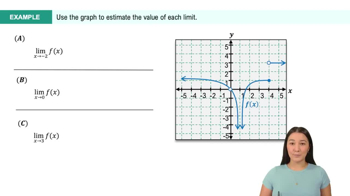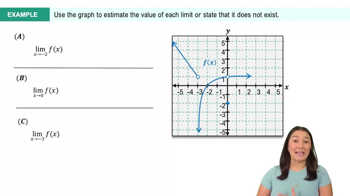Table of contents
- 0. Functions7h 52m
- Introduction to Functions16m
- Piecewise Functions10m
- Properties of Functions9m
- Common Functions1h 8m
- Transformations5m
- Combining Functions27m
- Exponent rules32m
- Exponential Functions28m
- Logarithmic Functions24m
- Properties of Logarithms34m
- Exponential & Logarithmic Equations35m
- Introduction to Trigonometric Functions38m
- Graphs of Trigonometric Functions44m
- Trigonometric Identities47m
- Inverse Trigonometric Functions48m
- 1. Limits and Continuity2h 2m
- 2. Intro to Derivatives1h 33m
- 3. Techniques of Differentiation3h 18m
- 4. Applications of Derivatives2h 38m
- 5. Graphical Applications of Derivatives6h 2m
- 6. Derivatives of Inverse, Exponential, & Logarithmic Functions2h 37m
- 7. Antiderivatives & Indefinite Integrals1h 26m
1. Limits and Continuity
Introduction to Limits
Problem 2.7.44
Textbook Question
Suppose x→alim f(x)=L. Prove that , where is a constant.
 Verified step by step guidance
Verified step by step guidance1
Start by recalling the definition of a limit: \( \lim_{x \to a} f(x) = L \) means that for every \( \epsilon > 0 \), there exists a \( \delta > 0 \) such that if \( 0 < |x - a| < \delta \), then \( |f(x) - L| < \epsilon \).
To prove \( \lim_{x \to a} (c \cdot f(x)) = cL \), we need to show that for every \( \epsilon > 0 \), there exists a \( \delta > 0 \) such that if \( 0 < |x - a| < \delta \), then \( |c \cdot f(x) - cL| < \epsilon \).
Notice that \( |c \cdot f(x) - cL| = |c| \cdot |f(x) - L| \). We can use the property of absolute values that \( |c| \cdot |f(x) - L| < \epsilon \) if \( |f(x) - L| < \frac{\epsilon}{|c|} \).
Since \( \lim_{x \to a} f(x) = L \), for every \( \epsilon' > 0 \), there exists a \( \delta > 0 \) such that if \( 0 < |x - a| < \delta \), then \( |f(x) - L| < \epsilon' \). Choose \( \epsilon' = \frac{\epsilon}{|c|} \).
Thus, for this choice of \( \epsilon' \), there exists a \( \delta > 0 \) such that if \( 0 < |x - a| < \delta \), then \( |c \cdot f(x) - cL| = |c| \cdot |f(x) - L| < |c| \cdot \frac{\epsilon}{|c|} = \epsilon \). This completes the proof that \( \lim_{x \to a} (c \cdot f(x)) = cL \).
Recommended similar problem, with video answer:
 Verified Solution
Verified SolutionThis video solution was recommended by our tutors as helpful for the problem above
Video duration:
3mPlay a video:
Was this helpful?

 6:47m
6:47mWatch next
Master Finding Limits Numerically and Graphically with a bite sized video explanation from Callie
Start learning





